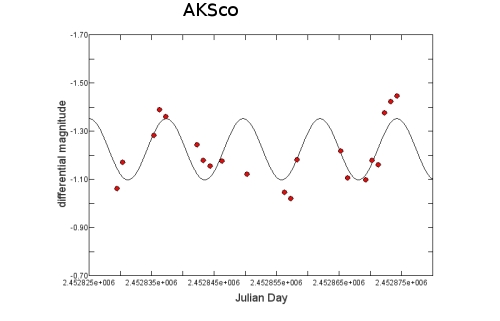| Article in PDF |
"Peremennye Zvezdy", Prilozhenie, vol. 6, N 10 (2006) |
Photometric monitoring of the pre-main sequence binary AK Sco
P. Pereira, J. M. Santos-Junior
Rio de Janeiro Planetarium Foundation, Rio de Janeiro, Brazil
| ISSN 2221–0474 |
Received: 9.03.2006; accepted: 25.03.2006
(E-mail for contact: pcpereira@pcrj.rj.gov.br)
| ||||||||||||||||||||||
Remarks: |
| We report photometric monitoring of the pre-main sequence binary AK Sco
covering about 45 days in 2003. The young nature of AK Sco was first
noted by Herbig & Rao (1972), based on a survey of Emission-Line Stars of the Orion
Population.
Nowadays we recognize AK
Sco as a double-lined spectroscopic binary with large eccentricity (e=0.47) and spectroscopic
orbital
period of 13.6 days (Andersen et al. 1989, Alencar et al. 2003). In the literature,
AK Sco shows irregular brightness
variations alternating with moments of Algol-like fading, with no conclusive evidence
for eclipses. In fact, many young stars show alternate
phases
of periodic and aperiodic variability with wide range of amplitudes and time scales
from minutes to several years. In the case
of AK Sco, variable circumstellar obscuration has been proposed
to explain the irregular variability (Kilkenny et al. 1985).
The data discussed in this paper were obtained with a SBIG ST8E CCD camera attached to the Meade LX200 10" Schmidt-Cassegrain (F/6.3) telescope of Rio de Janeiro Planetarium Foundation. We performed unfiltered differential photometry and the reduction was carried out with the IRAF software. Images were corrected for dark and flat-field effects. The uncertainty in the photometry of AK Sco is based on the standard deviation of the magnitude difference between comparison and check stars, and ranged from 0.005 to 0.01 mag. We focus on time scale of days having collected 786 frames during 21 nights. The light curve shows brightness variation with an amplitude of about 0.3 magnitude and changes reaching 0.2 magnitude from night to night. Period search was donne using the Phase Dispersion Minimization (PDM) technique (Stellingwerf 1978). First we gathered all data and calculated average values for each night to account for rapid variations. A prominent signal at a period of 12.4 days was found although weaker signals are present at 18 and 36 days as well. In view of the relatively short coverage, we cannot preclude them. We note that wave-like variation with a period of 10-15 days was already proposed (Hoffmeister 1958). The value of 12.4 days should be considered with caution. Acknowledgements. We are grateful to the referee for useful comments and suggestions. |
| References: |
| Alencar, S. H. P., Melo, C. H. F., Dullemond, C. P., Andersen, J., Batalha, C., Vaz,
L. P. R., Mathieu, R. D., 2003, A&A, 409, 1037
Andersen, J., Lindgren, H., Hazen, M. L., Mayor, M., 1989, A&A, 219, 142 Herbig, G. H., Kameswara Rao, N., 1972, ApJ, 174, 401 Hoffmeister, C., 1958, Veroeff. Sternwarte Sonneberg, 3, 333-437 Kilkenny, D., Whittet, D. C. B., Davies, J. K., Evans, A., Bode, M. F., Robson, E. I., Banfield, R. M., 1985, South Afr. Astron. Obs. Circ., 9, 55 Stellingwerf, R. F., 1978, ApJ, 224, 953 |
Light Curve
Light curve of AK Sco. The magnitude values are differential. The points are average values for each night. The solid line shows the best-fit sine curve (P=12.4 days) for better visualization. Data Source |